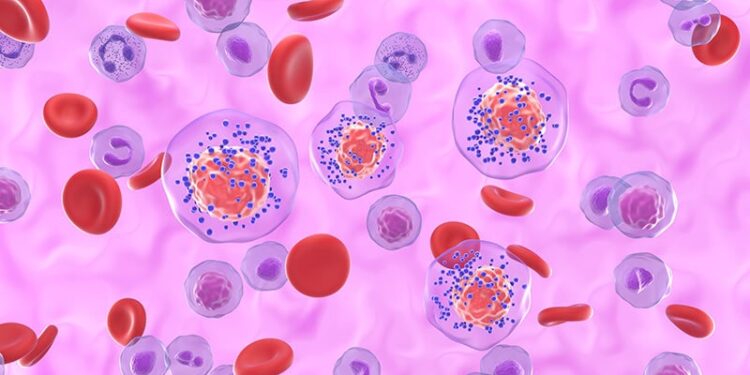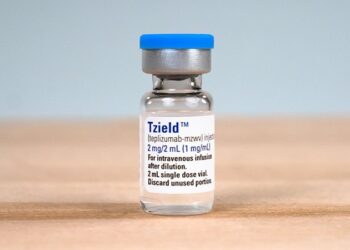Treatment with pembrolizumab and the antibody-drug conjugate (ADC) sacituzumab govitecan improved progression-free survival (PFS) in patients with PD-L1-positive locally advanced or metastatic triple-negative breast cancer (TNBC) compared with treatment with pembrolizumab and chemotherapy, the results of ASCENT-04/KEYNOTE-D19 showed.
Swapping in sacituzumab govitecan for chemotherapy led to a 3.4-month improvement in PFS and an almost twofold longer duration of response, with potentially fewer adverse events and a lower rate of discontinuations.
Currently, pembrolizumab with chemotherapy is the standard of care for PD-L1-positive TNBC, but the 3-year survival rate remains low at about 36%.
These findings support sacituzumab govitecan and pembrolizumab as the new standard for previously untreated patients in this setting, said lead investigator Sara Tolaney, MD, MPH, who presented the results at the American Society of Clinical Oncology (ASCO) 2025 annual meeting.
Once the new combination with sacituzumab govitecan, which targets the Trop-2 protein on tumor cells, is approved, “I would recommend it in the first-line setting,” said Tolaney, a breast medical oncologist at the Dana-Farber Cancer Institute, Boston, Massachusetts.
“I think this really does change the game for” PD-L1-positive metastatic TNBC, said study discussant Jane Meisel, MD, a breast medical oncologist at Emory University, Atlanta, Georgia. “I look forward to seeing this potentially make its way into clinical practice.”
The study included 443 women who had either de novo metastatic disease or were at least 6 months away from completing systemic therapy for early-stage disease. Patients had a combined positive PD-L1 score of 10 or higher, and about 40% of TNBC tumors expressed the Trop-2 protein.
Half of the patients were randomly assigned to 10 mg/kg sacituzumab govitecan on day 1 and day 8, plus pembrolizumab 200 mg on day 1 of 21-day cycles for a maximum of 35 cycles (n = 221). The other half were randomly assigned to pembrolizumab on the same schedule plus investigators’ choice of gemcitabine plus carboplatin or paclitaxel/nab-paclitaxel (n = 222).
Approximately 5% of patients had received a prior checkpoint inhibitor for earlier-stage disease; 43% of women in the chemotherapy arm crossed over to sacituzumab govitecan monotherapy after progression.
At a median follow-up of 14 months, median PFS was 11.2 months in the sacituzumab govitecan group vs 7.8 months in the chemotherapy group, which translated to a 35% lower risk of cancer progression during follow-up (hazard ratio [HR], 0.65; P = .0009).
Tolaney noted that PFS in the ADC group increased with higher Trop-2 expression, but the ADC group also did better than the chemotherapy arm regardless of Trop-2 levels, suggesting that “you didn’t need to preselect patients for use of sacituzumab by Trop-2.”
Median duration of response was 16.5 months with sacituzumab govitecan vs 9.2 months with chemotherapy. Although overall survival follow-up is ongoing, the trend favors the ADC group (HR, 0.89).
Commenting on the study, Julie Gralow, MD, a breast medical oncologist at the University of Washington, Seattle, noted that sacituzumab govitecan is already indicated as monotherapy in the third or later lines for metastatic disease. The ASCENT-04 results “will likely move this drug, this regimen, earlier in the metastatic setting” for TNBC, Gralow agreed.
On the side effect front, the most common (≥10% of patients) grade 3 and 4 adverse events in the sacituzumab govitecan group were neutropenia (43%) and diarrhea (10%); in the chemotherapy group, the most common adverse events were neutropenia (45%), anemia (16%), and thrombocytopenia (14%).
Serious adverse events were numerically more common in the ADC arm (38 vs 31), but there were fewer dose reductions and fewer treatment discontinuations than with chemotherapy.
“The nice thing is that many of us have used both of these agents, sacituzumab and pembrolizumab, quite a bit,” and with no new safety signals, breast oncologists will “feel comfortable with [the combination] once it makes its way into the clinic,” Meisel said.
The work was funded by Gilead Sciences, maker of sacituzumab govitecan. Tolaney disclosed research and travel funding from Gilead and is a Gilead advisor. Gralow and Meisel reported no relevant financial relationships.
M. Alexander Otto is a physician assistant with a master’s degree in medical science and a journalism degree from Newhouse. He is an award-winning medical journalist who worked for several major news outlets before joining Medscape. Alex is also an MIT Knight Science Journalism fellow. Email: [email protected]
Source link : https://www.medscape.com/viewarticle/sacituzumab-or-chemo-first-line-tnbc-which-better-2025a1000eqg?src=rss
Author :
Publish date : 2025-05-31 14:40:00
Copyright for syndicated content belongs to the linked Source.














